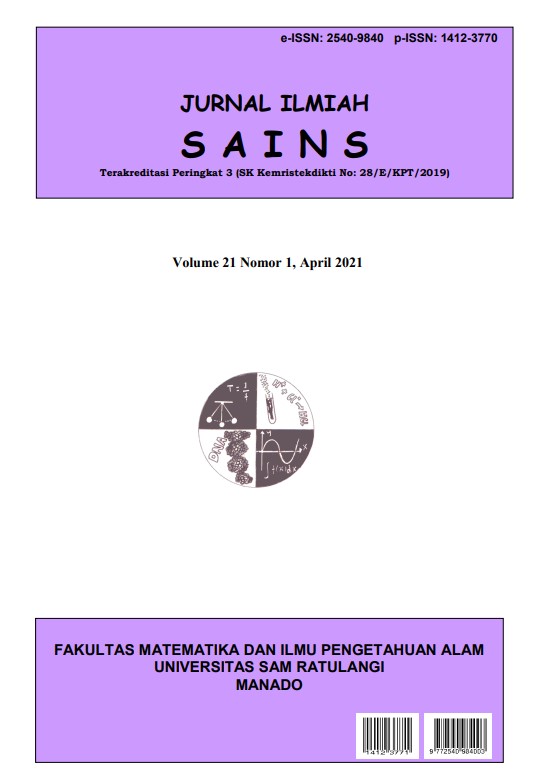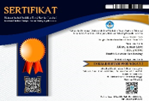Abundance and Species Composition of Cave Bats (Mammalia: Chiroptera) in Selected Key Biodiversity Areas (KBAs) of Central Visayas, Philippines
DOI:
https://doi.org/10.35799/jis.21.1.2021.31238Abstract
This study assessed the abundance and species richness of bats (Order Chiroptera) inhabiting caves in three KBAs (Key Biodiversity Areas) of Central Visayas: Mt. Bandilaan in Siquijor (13 caves), Mabinay, Negros Oriental (11 caves), and Rajah Sikatuna Protected Landscape(RSPL) in Bohol (31 caves). The study was conducted between February 14 to September 20, 2019. Of the 55 caves surveyed, 35 caves were inhabited by bats. Field survey methods included mist-netting at the cave entrances and direct observations of roosting sites in each cave. This study captured 754 individuals of bats belonging to 16 species, majority of which are insectivorous species (13 species) and only three species are fruitbats (Pteropodidae). Mabinay caves had the highest number of species (11) and captured bats (271 individuals) while RSPL had 9 species (221 individuals) while Mt. Bandilaan only had five species but relatively high captured bats (262 individuals). Five species are Philippine endemics (Hipposideros obscurus, Hipposideros pygmaeus, Ptenochirus jagori, Rhinolophus inops, and R. rufus) and three Near-threatened species (H. lekaguli, M. schreibersii, and R. rufus). The rare bat species (Dobsonia chapmani) may be locally extirpated in Mabinay, where it last documented at Mambajo cave in the 1960s. The survey also noted the absence of fruit bats (observed in 2011 study) in all of the caves in Mt. Bandilaan, probably due to on-going anthropogenic activities (treasure hunting, bat hunting, guano extraction, land conversion, locals illegal entry, graffiti, etc) in caves surveyed. Large colonies of fruitbats and insect bats in RSPL may have been affected by anthropogenic activities inside the caves. Most of the caves surveyed have been promoted for ecotourism activities.
Keywords: cave; chiropteran; extraction; karst; limestone
References
Alcala, E.L., Averia, L., Tababa, L., Dagunan, M.A., Tababa, R., Dasian, J., Libo-on, E.V. & Ocampo, M. 2007. Assessment of the biophysical condition of caves promoted for ecotourism in Mabinay, Negros Oriental, Philippines. Sil J, 48(1):19-31.
Alcala, M.L.R., Bucol, A.A., Averia, L.T., Alcala, E.L. & Basa, J.E.P. 2011. Biodiversity and Management Status of Selected Caves in the Visayas, Philippines. A paper presented during the Biodiversity Conference, PICC, Manila, February 1-3, 2011.
Alviola, P.A., Macasaet, J.P.A., Afuang, L.E., Cosico, E.A. & Eres, E.G. 2015. Cave-dwelling bats of Marinduque Island, Philippines. Museum Publ Nat Hist, 4(1): 1-17.
Balete, D.S. 2010. Food and roosting habits of the lesser false vampire bat, Megaderma spasma (Chiroptera: Megadermatidae), in a Philippine lowland forest. Asia Life Sci 4:111-129.
Hammer, Ø., Harper, D.A.T., Ryan, P.D. 2001. Paleontological Statistics Software: Package for Education and Data Analysis. Palaeontol Electron, 4(1):1-9.
Heaney, L.R., Dolar, M.L., Balete, D.S., Esselstyn, J.A., Rickart, E.A. & Sedlock, J.L. 2010. Synopsis of Philippine mammals. Field Museum of Natural History. Internet resource (http://www. fieldmuseum. org/philippine_mammals/).
Hodgkison, R., Balding, S.T., Zubaid, A. & Kunz, T.H. 2003. Fruit Bats (Chiroptera: Pteropodidae) as seed dispersers and pollinators in a lowland malaysian rain Forest1. Biotropica 35(4): 491-502.
Ingle, N.R. & Heaney, L.R. 1992. A key to the bats of the Philippine Islands. Publication (USA): 44 pp.
IUCN. 2019. The IUCN Red List of Threatened Species. Version 2019-2. <https://www.iucnredlist.org>. Accessed: October 7, 2019.
Kunz, T.H., Braun, de Torrez E., Bauer, D., Lobova, T. & Fleming, T.H. 2011. Ecosystem services provided by bats. Ann NY Acad Sci, 1223(1):1-38.
Mikula, P., Morelli, F., LuÄan, R.K., Jones, D. N. & Tryjanowski, P. 2016. Bats as prey of diurnal birds: a global perspective. Mammal Rev, 46(3):160-174.
Mould, D.R. 2012. Models for Disease Progression: New Approaches and Uses. Clinical Pharmacology & Therapeutics, 92(1): 125–131. DOI:10.1038/clpt.2012.53.
Phelps, K., Jose, R., Labonite, M. & Kingston, T. 2016. Correlates of cave-roosting bat diversity as an effective tool to identify priority caves. Biol Cons, 201: 201-209.
Quibod, M.N.R.M., Alviola, P.A., de Guia, A. P.O., Cuevas, V.C., Lit Jr, I.L. & Pasion, B.O. 2019. Diversity and threats to cave-dwelling bats in a small island in the southern Philippines. J Asia-Pac Biodiv, 12(4): 481-487.
Sedlock, J.L., Jose, R.P., Vogt, J.M., Paguntalan, L.M.J. & Cariño, A.B. 2014. A survey of bats in a karst landscape in the central Philippines. Acta Chiropterol, 16(1):197-211.
Sedlock, J.L., Gomez, R.K.S. 2010. Philippine Cave Bats in Crisis? An Assessment of Cave Bats on Siquijor Island. Bat Research News, 51(4): 183-184.
Sothearen, T., Furey, N.M. & Jurgens, J.A. 2014. Effect of bat guano on the growth of five economically important plant species. J Trop Agr, 52(2):169-173.
Tababa, R., Dagunan, M.A., Dejano, B., De La Cruz, S., Gutierrez B., Alcala, E. & Averia, L. 2012. Preliminary results of the cave bat assessment conducted at Central Negros, Philippines. LCC Dev. Educ. J. Multidiscip. Res 1:85-99.
Tanalgo, K.C. & Tabora, J.A.G. 2015. Cave-dwelling bats (Mammalia: Chiroptera) and conservation concerns in South central Mindanao, Philippines. Journal of Threatened TAXA, 7(15). http://doi.org/10. 11609/jott.1757.7.15.8185-8194.
Williams-Guillén K., Perfecto, I. & Vandermeer, J. 2008. Bats limit insects in a neotropical agroforestry system. Science, 320(5872):70-70.







